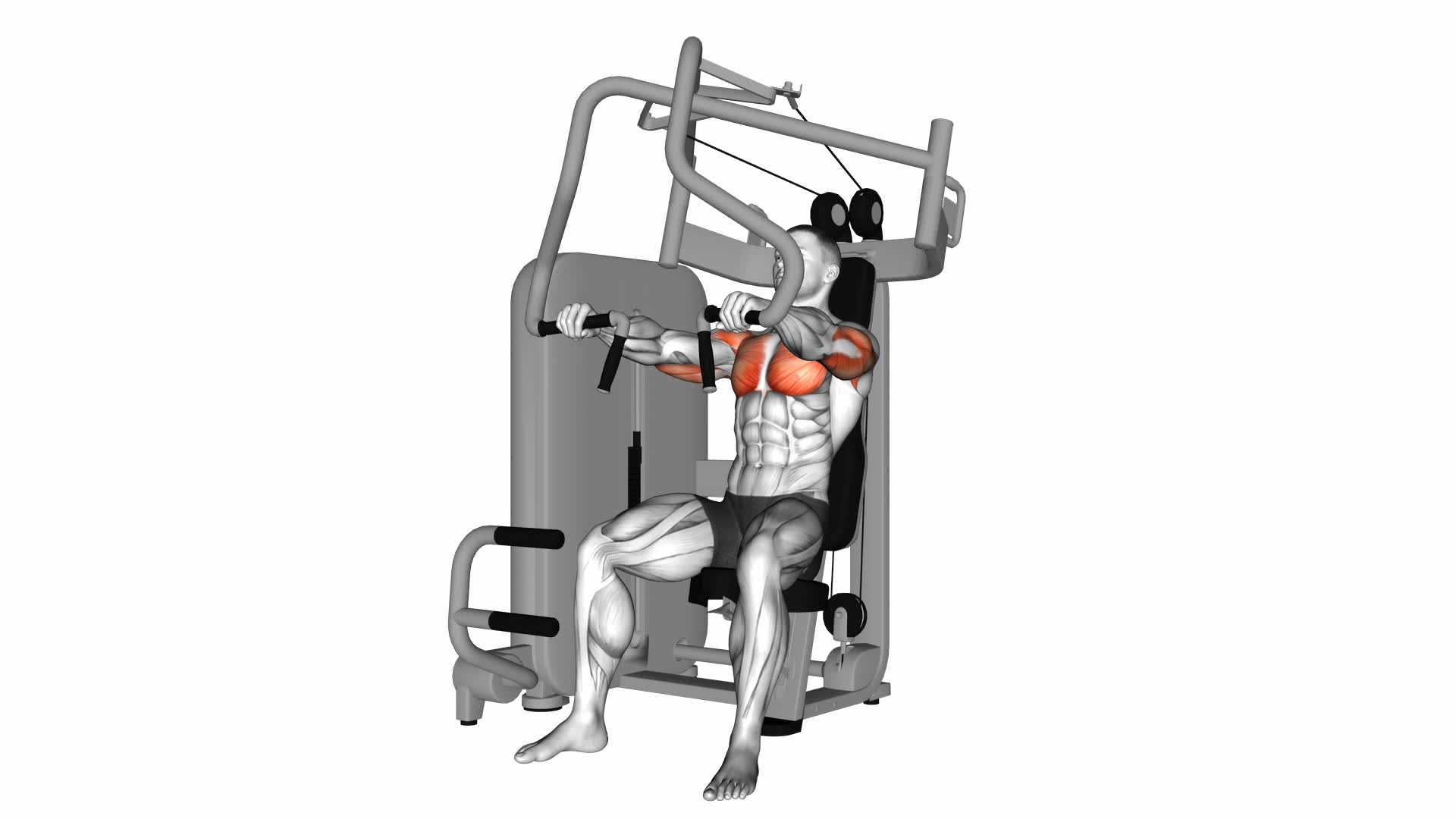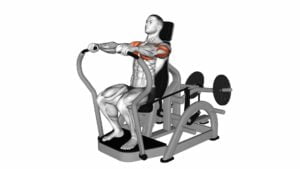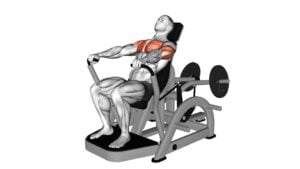Lever Chest Press (VERSION 5) – Video Exercise Guide & Tips

Are you looking to strengthen your chest muscles? Look no further than the Lever Chest Press (Version 5).
Watch This Exercise Video
In this video exercise guide, we'll show you the proper technique and form for maximum effectiveness. With variations and modifications available, you can tailor this exercise to your fitness level.
Avoid common mistakes and get the most out of your workout with our expert tips.
Get ready to see results with the Lever Chest Press.
Key Takeaways
- The lever chest press activates multiple muscles in the upper body.
- It is effective for building strength and muscle mass.
- The exercise targets pectoral muscles, triceps, deltoids, and core muscles.
- It helps prevent injuries by providing a controlled range of motion.
Benefits of the Lever Chest Press
You can experience several benefits from performing the Lever Chest Press exercise. This exercise is known for its ability to activate multiple muscles in your upper body, making it an effective choice for building strength and muscle mass.
The Lever Chest Press primarily targets your pectoral muscles, but it also engages your triceps, deltoids, and even your core muscles to stabilize your body during the movement. By working these muscle groups together, you can achieve a balanced and well-rounded upper body workout.
Additionally, the Lever Chest Press can help prevent injuries. It provides a controlled and guided range of motion, reducing the risk of straining or overextending your muscles. The machine's design ensures stability and proper alignment, minimizing the chances of putting excessive stress on your joints.
This exercise also allows you to adjust the resistance according to your fitness level, ensuring that you can challenge yourself without compromising your safety.
To fully benefit from the Lever Chest Press, it's important to maintain proper technique and form. By following the correct instructions provided by a fitness professional or using a video guide, you can maximize the effectiveness of this exercise while minimizing the risk of injury.
Proper Technique and Form
To ensure optimal results and minimize the risk of injury, it's crucial to maintain proper technique and form while performing the Lever Chest Press exercise. This can be achieved by following a few key guidelines.
First, make sure to adjust the weightlifting equipment to your body proportions. This will ensure that you're in a stable and comfortable position throughout the exercise.
Secondly, focus on activating the targeted muscles, which in this case are the chest, shoulders, and triceps. To do this, keep your shoulder blades pressed firmly against the bench and engage your core muscles. As you push the handles forward, exhale and contract your chest muscles. Be mindful of not locking your elbows at the top of the movement, as this can strain the joints.
Finally, maintain a controlled and steady pace throughout the exercise, avoiding any jerking or bouncing motions. By practicing proper technique and form, you'll maximize muscle activation and reduce the risk of injury.
Now, let's move on to the next section where we'll explore variations and modifications of the Lever Chest Press exercise.
Variations and Modifications
To explore variations and modifications of the Lever Chest Press exercise, let's now delve into different ways to challenge and target specific muscle groups. For those looking to take their workout to the next level, advanced lever chest press variations can provide an extra challenge. One option is to perform the exercise on an incline bench, which targets the upper chest muscles more intensely. Another variation is the decline lever chest press, which emphasizes the lower chest muscles. Additionally, using a wide grip during the exercise can engage the outer chest muscles, while a narrow grip focuses on the inner chest muscles.
On the other hand, beginners or those with limited strength may benefit from modified lever chest press exercises. One modification is to perform the exercise with lighter weights or resistance bands to reduce the load on the muscles. Another option is to use a stability ball instead of a bench, which adds an element of balance and stability training. Finally, performing the exercise with a partner can provide added support and assistance if needed.
Remember to always consult with a fitness professional before attempting any advanced variations or modifications to ensure proper form and technique.
Common Mistakes to Avoid
Continuing from the previous subtopic on variations and modifications, it's important to be aware of common mistakes to avoid when performing the Lever Chest Press exercise. By avoiding these mistakes and correcting any errors in your form, you can maximize the effectiveness of the exercise and minimize the risk of injury.
One common mistake to avoid is using too much weight. While it may be tempting to lift heavier weights, using too much weight can compromise your form and lead to improper muscle engagement. Start with a weight that allows you to perform the exercise with proper technique, and gradually increase the weight as you become more comfortable and confident.
Another mistake to avoid is arching your back. It's important to maintain a neutral spine throughout the exercise to protect your lower back. To correct this error, engage your core muscles and focus on keeping your back flat against the bench.
Lastly, avoid rushing through the exercise. Performing the Lever Chest Press too quickly can lead to poor form and reduced muscle activation. Take your time and focus on the quality of each repetition.
Tips for Maximizing Your Results
Now let's delve into how you can optimize your results from the Lever Chest Press exercise. To maximize your gains, it's important to pay attention not only to your workout routine but also to your diet and recovery strategies.
First, let's talk about diet tips. For optimal results, make sure you're consuming enough protein to support muscle growth and repair. Aim for around 1 gram of protein per pound of bodyweight. Also, be mindful of your overall calorie intake. To build muscle, you may need to consume slightly more calories than you burn, but be careful not to overeat and gain excess fat.
In addition to diet, recovery strategies play a crucial role in maximizing your results. Allow your muscles ample time to rest and recover between workouts. This means incorporating rest days into your routine and getting enough sleep. Proper hydration is also essential for optimal recovery.
Finally, consider incorporating active recovery techniques such as foam rolling or light stretching to improve circulation and reduce muscle soreness.
Frequently Asked Questions
How Much Weight Should I Start With When Doing the Lever Chest Press?
When starting the lever chest press, it's important to consider your current strength level and proper form.
To improve strength effectively, begin with a weight that challenges you but allows you to maintain proper form throughout the exercise.
Starting with too heavy of a weight can lead to poor form and potential injury.
Gradually increase the weight as you become more comfortable and confident with the exercise.
Can the Lever Chest Press Help With Improving Posture?
The lever chest press can be beneficial for improving your posture. By engaging your chest, shoulders, and upper back muscles, this exercise helps to strengthen and stabilize the muscles involved in maintaining proper posture.
To maximize the benefits, it's important to focus on using proper technique. This includes keeping your back straight, shoulders down and back, and maintaining a controlled and steady movement throughout the exercise.
Is It Necessary to Warm up Before Performing the Lever Chest Press?
Before you perform the lever chest press, it's important to warm up. Warming up helps increase blood flow to your muscles, preparing them for exercise and reducing the risk of injury. It also helps to improve your range of motion and flexibility.
When performing the lever chest press, make sure to maintain proper form and technique. Keep your back flat against the bench, engage your core, and focus on pushing through your chest.
Can the Lever Chest Press Be Performed by People With Shoulder Injuries?
If you have a shoulder injury, it's important to consult with a healthcare professional before attempting the lever chest press. They can provide modifications or alternative exercises that will be safer for your shoulder.
It's crucial to prioritize your recovery and avoid further injury. Listen to your body and don't push yourself too hard.
Take care and work with a professional to find the best exercises for you.
How Often Should I Include the Lever Chest Press in My Workout Routine?
To optimize your workout routine, it's important to consider the frequency of including the lever chest press.
The lever chest press is a beneficial exercise that targets your chest muscles.
However, the optimal frequency of including this exercise may vary depending on your fitness goals, current fitness level, and overall workout routine.
It's recommended to consult with a fitness professional to determine the appropriate frequency and variations of the lever chest press for your specific needs.
Conclusion
In conclusion, the lever chest press is a beneficial exercise that can help strengthen and tone your chest muscles. By using proper technique and form, you can maximize your results and avoid common mistakes.
Additionally, there are variations and modifications available to suit your fitness level and goals. Incorporating this exercise into your workout routine can contribute to overall upper body strength and improve your fitness journey.

Author
Years ago, the spark of my life’s passion ignited in my mind the moment I stepped into the local gym for the first time. The inaugural bead of perspiration, the initial endeavor, the very first surge of endorphins, and a sense of pride that washed over me post-workout marked the beginning of my deep-seated interest in strength sports, fitness, and sports nutrition. This very curiosity blossomed rapidly into a profound fascination, propelling me to earn a Master’s degree in Physical Education from the Academy of Physical Education in Krakow, followed by a Sports Manager diploma from the Jagiellonian University. My journey of growth led me to gain more specialized qualifications, such as being a certified personal trainer with a focus on sports dietetics, a lifeguard, and an instructor for wellness and corrective gymnastics. Theoretical knowledge paired seamlessly with practical experience, reinforcing my belief that the transformation of individuals under my guidance was also a reflection of my personal growth. This belief holds true even today. Each day, I strive to push the boundaries and explore new realms. These realms gently elevate me to greater heights. The unique combination of passion for my field and the continuous quest for growth fuels my drive to break new ground.







